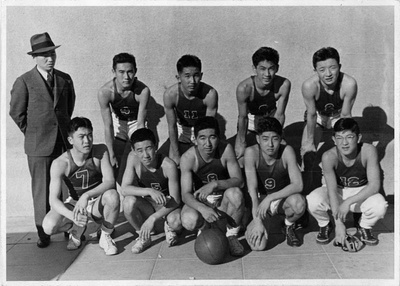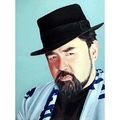We asked writer Paul Yamada about his background and what it was like for him growing up Hapa. He noted that unlike most early Hapa families, it was his father that was Japanese American—not his mother. This article presents his parents’ backgrounds as an introduction of where he came from and will be followed with more in the future in which he describes himself and his experiences being of mixed race.
My mother was born Marjorie Ann Lehmann in August, 1927 to Anna Bell and August Lehmann, in a house east of Broadway that overlooked the Mississippi river. Her two sisters, Annabelle (the younger) and Emma were both in their twenties when she was born.
Both Anna Bell’s parents, Anna Langmeier and “grandpa” Beel (which was changed to Bell during immigration) were of Bohemian descent, from Prague. Marjorie’s father, August Lehmann had arrived in St. Louis from Oldenberg, Germany, by 1904, or earlier. He was half German—and those folks were lapsed Jews—and half Alsatian. However, the ethos in the Lehman household was decisively Bohemian. My mother and her sisters never represented themselves as being anything but Slavic and Bohemian, and they viewed certain elements of the St. Louis German community with mild disdain. This continued for all of them, despite the fact that both sisters married German American men who were prominent, and in Emma’s case, wealthy.
Six months or so after Marjorie was born, her father had a severe coronary and died. By the end of the 1930s, Anna sold their house and she and Marjorie moved to a smaller house not too far away near Carondolet Park. This neighborhood was a mix of Bohemians, Poles and Germans. Marjorie did well despite the move and made girlfriends that were still dear to her when she died, close to 70 years later. Her life did not remain stable, for sometime after she turned eleven, her mother was run over by a city bus. This sad accident was worsened by the circumstances: Anna Lehmann was attempting to ride the bus in a blizzard because her daughter Annabelle had begged her to come and deliver her second child, and had NOT provided fare for a cab.
Marjorie was sent to an orphanage, but after a few weeks, the father-in-law of her sister Emma insisted that such a deed was a stain on his Calvinist-E&R conscience, and he essentially bribed the sisters Emma and Annabelle to take Marjorie in and raise her. So, from sometime in 1939 until she graduated from college (Washington University, BA, 1949, Chemistry major, anatomy minor) Marjorie lived with Emma or Annabelle.
Emma, who had married into wealth, more or less treated Marjorie like a daughter. Marjorie seems to have gotten along with Emma’s only child, a daughter, though this was not really the case after they each married. The situation at Annabell’s was much more complicated. She had two daughters and later, a son, and there was less money in the family. My mother was treated more like a servant in that household, and these ten years laid the groundwork for extremely complicated relationships between the three sisters, which featured lots of envy, recrimination and argument. This was also the scene of the crime, so to speak, of my mother’s rampant insecurities, her temper tantrums and her overall, emotional fragility and “fly off the handle” personality.
These changes were pretty drastic, since during her first eleven years she was an only child by default, with a doting, virtually old world mother, who baked and marketed everyday, and who made many things from scratch, like root beer, beer, schnaps and “fruit compote” liquors. The Bohemian side of her family did not recognize Prohibition, and this included her mother. Life with Emma was somewhat similar, but with Annabelle, who had trouble boiling water, much less doing so voluntarily, her life was considerably different, and she was frequently the maid and servant to her own sister and nieces.
In 1941 she was sent to Ursuline Academy, a Catholic high school, despite the severe Calvinist beliefs of her sister Emma’s in-laws. She then went to college, graduating in 1949. Shortly thereafter she landed a job as a “line chemist” for Lambert Pharmaceutical, which still exists as Warner-Lambert, and still makes Listerine, the product she tested daily for impurities.
It is worth noting that she seems to have had no religious instruction and no church-going while she lived with her mother, as those Bohemians had been “free thinkers”. There is no evidence that her two sisters were sent to, or taken to, church either. Neither the E&R faith nor the Catholicism of her high school changed her casual attitudes about religion.
It is also worth noting that my mother seems to have been very sheltered and naïve socially and culturally. I do not think she knew anyone of color except Emma’s maids before attending college. Most of her high school friends I met over the years had become nuns, and when I would ask her what music she listened to in high school and college (1941 through 1949) she could never remember ANYTHING. In my world, I call this kind of person a SQUARE, and in many ways, so she was, especially compared to my father.
At some point during the early 1950s, she seems to have timidly decided to pursue at least an MA in chemistry and organic chemistry, which is how she met Mas Yamada who was an instructor at the college, and who later became my father. Evidently she did not do very well in his class and I think he was instrumental in her decision NOT to keep trying for that MA. At some point after this, they began dating.
Before I sketch my father, let me recount one interesting story. In 1953 when my parents were officially engaged, my mother and father went to meet Emma’s minister to begin the marriage preparations. Since Emma’s father-in-law was deceased, she and her family were attending an old-line, prosperous Presbyterian church. When Marjorie and Mas walked into his office, he looked at them and announced, “It is illegal in the state of Missouri for me to marry you, so I can’t marry you, and I would not marry you two anyway.”
No member of her family stepped up to try to “rectify” this situation, and the two of them ended up going to Iowa and being married by a man who was a friend or relative of a friend. NONE of her family chose to accompany them. NONE. A few of my father’s relatives did attend, despite the fact that he had virtually nothing to do with any of them since 1943.
My father, Mas Yamada, was born in West Oakland, CA in September 1921. His father was Masaoki Yamada and his mother was Masao Shirasuna. They were both from Yamanashi Ken. Masaoki came to the States before WWI, allegedly to go to college. His lack of English, however, thwarted that desire and before the war ended, he returned to Japan, got married, and returned to Oakland. With him was another man, who married a sister of Masao.
Mas had 9 siblings. One did not make it out of infancy, so he ended up being the middle child of the surviving nine. He was something of a rebel. He was the first to protest having a rice bowl hair-cut—and had a scar on his head from the Japanese scissors his father used to make a reply—and became the first in the family to go to a barber. He was also the first to protest Japanese lessons and afterschool shifts in the family laundry, because both conflicted with afterschool sports. He excelled in track and basketball, and lettered in track at Oakland Tech. He also played basketball for a church team, where he was friends with Goro Suzuki, better known from the TV show “Barney Miller,” as Jack Soo. He also lettered in track at the University of California, Berkeley.

Masaoki died in 1933 before Mas turned 12. This was quite a loss to the family, especially since he had used the laundry truck to make deliveries of bootleg potables. Mas went to UCB on scholarship and found a way to buy a Model-T, which he lost, along with the first semester of his junior year, when he was rounded up for relocation. All the Yamadas and relatives in the Shirasuna branch went to the Topaz camp (except one or two who went to Heart Mountain). He remained there until making contact with a Quaker man who was a botany professor at Washington University, and with his assistance, he enrolled there for the Spring, 1943 semester.
Mas lived with this professor and his wife in a cottage inside the grounds of the Missouri Botanical Gardens. Everyday when he would wait for the bus, a crowd would assemble across the street, jeering him, insulting him, and throwing rocks and bottles at him. Such was his reception in St. Louis. His work at UCB was advanced enough that there was no equivalent at Wash U, and so by the time he received a draft notice, for the Spring of 1944, he was awarded a degree and thus went to OTC.
He was sent overseas as a Second Lieutenant during late fall of 1944 and saw combat in Germany. His military papers confirm that he was a platoon leader who probably commanded 37 men who either hated him or distrusted him. His tour ended in 1948 and during a call “home” to Chicago, as virtually everyone had gone there after getting out of Topaz, whichever sister answered the phone made the mistake of alluding to a “bride” that his Obasan had picked out, and instead of going to Chicago, he went directly back to St. Louis and did not have any contact with his family until his youngest sister June graduated from Grinnell College in Iowa. Sometime before midnight he appeared at the back door of the apartment June and his mother lived in. He refused to join the party, or even say hello to anyone, insisting that he had a present for June and she either came with him, anonymously, or he would leave for St. Louis. June decided to go with him, and he took her to a midnight show of Sarah Vaughn at the (black) Pershing Hotel.
Although Mas missed much music and culture while in Topaz and combat, his musical interests were jazz and blues: Jimmy Rushing, Wynonie Harris, Count Basie, Duke Ellington, Lionel Hampton, Lester Young, Coleman Hawkins, Charlie Parker, and many others. I have actually seen photos from the first Charlie Parker shows in St. Louis, and he is in them. He is the only non-black in the photo. Some of this was a result of the southern Jim Crow conditions there. Much later in life he told me that the St. Louis ballrooms that featured prominent “white” bands, like Woody Herman, would not let him in, so he frequented all the black clubs and occasionally went to Illinois to see Herman or Charlie Barnett.
It seems that Mas had nothing to do with his family after returning from Europe until he got married. Despite the wonderful cooking lessons Marjorie received in Chicago, Mas was never very interested in seeing his family, though we did usually go to Chicago at X-mas and in June because I had a birthday. Only a few of his family members visited, and even fewer were invited. By the end of the 1960s there were no family ties left. Since we have come to 1953, when my parents were married—and I come around a year later—I shall close this introduction.
© 2010 Paul Yamada




